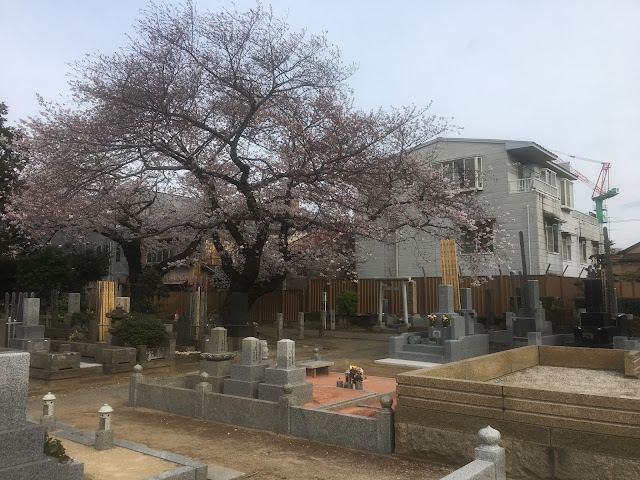A Startling Contrast Between Pink and Grey! The Vivid Sakura At The Yanaka Cemetery
The pink sakura brighten up an otherwise solemn cemetery.
It's a beautiful life.
I'm not saying that my entire life has always been dotted with rainbows and unicorns, but I'm a hundred percent certain that my life is blessed by a Magnanimous Being that watches over all His creation. And I think that's something to gloat about. However if there is beauty in life, could there also be beauty in death?
(Related post: Pondering About Life: My Birthday Staycation In Pampanga!)
Recently, I went on a twelve-day pleasure trip to Japan with my mother, two siblings, and three-year old niece. I was (as usual) assigned with the itinerary which I peppered with kid-friendly attractions and activities. At around 5:00 PM on April 2, 2017, as we were traveling to our rental apartment aboard the Joban Line train to Mikawashima, I caught sight of a specific scene of beauty with the setting sun serving as its backdrop. I decided to pay a solo visit first thing the following morning as a side trip.
Nippori station.
A quick consult with Google Maps informed me that the place was a prime spot for cherry blossom viewing called Yanaka Cemetery and that it was a short walk from Nippori station.
You have to cross "Momiji" Bridge to get to the cemetery. There are also exits within Nippori station that lead right into the bridge.
An array of old Japanese houses on the left versus skyscrapers and modern buildings on the right.
If you see this sign, you're on the right track.
This mischievous little kitsune looks a wee bit surprised that it was caught.
Here in Japan, the people just leave their stuff in their garages unattended, not worrying that it might get stolen. That is how confident the citizens are of their country's security status.
Welcome to the Yanaka Cemetery.
Upon entry into the cemetery, a line of cherry blossom trees providing shade to hundreds upon thousands of graves greeted me and I was overwhelmed with the feeling of calmness and serenity. Walking around the graves while breathing in the cold, crisp springtime air was a welcome change of pace from all the over-hyped gallivanting we've been doing around Central Tokyo for the past few days following our arrival. It provided me with an opportunity to think about what I've been going though in life: pressure from the workplace, dealing with turmoils among my circle of peers, and recovering from a broken heart (this last one being the hardest to chew on). At the very least, the casual stroll provided me with a quick breather from it all.
(Related post: I've noticed that I've been thinking about my life more frequently as of late. Find out more about it here.)
Sakura-viewing at the cemetery is a more solemn affair as compared to the hanami in parks. Obviously, visitors won't be allowed to set out picnic mats on the cemetery grounds and eat or drink under the fresh, pink blossoms. The only way to enjoy the cherry blossoms is to just leisurely walk along the road and among the graves.
A typical Japanese grave. According to statistics, 99.81% of deceased Japanese are cremated.
I asked our gracious host, Sakura-san, about what the Japanese believe about death. She said that while modern Japanese people are mostly non-religious, Buddhism has shaped their culture. The Japanese believe in the concept of reincarnation guided by the Bodhisattva, and that they do the Buddhist rite every seven years from the time of death until 33 years from death. Sakura-san claimed that nowadays there are not many contemporary people who believe in reincarnation, but some do without putting it on the table.
According to Wikipedia, a Japanese funeral (葬儀 sōgi or 葬式 sōshiki) includes a wake, the cremation of the deceased, a burial in a family grave, and a periodic memorial service. A typical Japanese grave is usually a family grave consisting of a stone monument, with a place for flowers, incense, and water in the front and a chamber or crypt underneath for the ashes. The date of the erection of the grave and the name of the person who purchased it may be engraved on the side of the monument.
There's a grave under an orange tree. So cute.
An orange as an offering to the dead. In the Philippines we call it an atang.
A grave apartment-- sort of like a rental grave.
Some of the more majestic-looking graves that commands a second look and a lot of respect.
This sealed-off grave comes with a garden. It is where Tokugawa Yoshinobu is buried.
Residential houses near the cemetery. On one side of the cemetery, you can even see Tokyo tower.
The Yanaka Cemetery has a rest area and playground.
Right beside the cemetery is the beautiful Tennoji Temple complex.
The blossoms in this particular tree are pink-er than the others!
There is something that I have learned from my visit to Yanaka Cemetery. From the time of its full bloom, a sonmei yoshino cherry blossom (like the ones found inside the cemetery) will only have less than a week before it will inevitably fall off from the tree. Beautiful as the blossom is, it is a stark reminder that its beauty will not last forever. Life can somewhat be described the same way, too. No matter what the obstacles, it will always be beautiful simply because of the fact that it is God-given. But it will not last forever. While it lasts, it needs to be treasured and lived to the fullest so that its beauty will always be remembered-- just like the cherry blossoms.




































































😘
ReplyDeleteHehehe. Thank you for visiting! Please check back na rin for more posts and enjoy reading, Daddy Frank! ;)
Delete😘
ReplyDelete